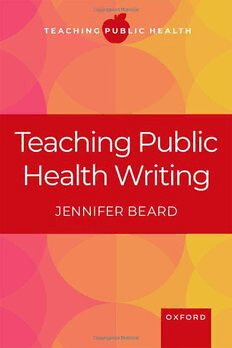
Teaching Public Health Writing PDF
Preview Teaching Public Health Writing
T E A C H I N G P U B L I C H E A LT H W R I T I N G TEACHING PUBLIC HEALTH Teaching Public Health offers instructors state- of- the- science tools and resources to support inte- gration of new topics and pedagogical strategies that can promote active, engaged, and innovative learning in academic public health. Series Editors LISA SULLIVAN, Boston University School of Public Health SANDRO GALEA, Boston University School of Public Health Teaching public health writing Jennifer Beard TEACHING PUBLIC HEALTH WRITING Jennifer Beard Oxford University Press is a department of the University of Oxford. It furthers the University’s objective of excellence in research, scholarship, and education by publishing worldwide. Oxford is a registered trade mark of Oxford University Press in the UK and certain other countries. Published in the United States of America by Oxford University Press 198 Madison Avenue, New York, NY 10016, United States of America. © Oxford University Press 2022 All rights reserved. No part of this publication may be reproduced, stored in a retrieval system, or transmitted, in any form or by any means, without the prior permission in writing of Oxford University Press, or as expressly permitted by law, by license, or under terms agreed with the appropriate reproduction rights organization. Inquiries concerning reproduction outside the scope of the above should be sent to the Rights Department, Oxford University Press, at the address above. You must not circulate this work in any other form and you must impose this same condition on any acquirer. Library of Congress Cataloging-in-Publication Data Names: Beard, Jennifer, PhD, author. Title: Teaching public health writing / Jennifer Beard. Description: New York, NY : Oxford University Press, [2022] | Includes bibliographical references and index. Identifiers: LCCN 2022014936 (print) | LCCN 2022014937 (ebook) | ISBN 9780197576465 (paperback) | ISBN 9780197576489 (epub) | ISBN 9780197576496 Subjects: MESH: Writing | Public Health—education | Students, Public Health Classification: LCC R119 (print) | LCC R119 (ebook) | NLM WA 18 | DDC 808.06/661—dc23/eng/20220412 LC record available at https://lccn.loc.gov/2022014936 LC ebook record available at https://lccn.loc.gov/2022014937 DOI: 10.1093/ oso/9 780197576465.001.0001 This material is not intended to be, and should not be considered, a substitute for medical or other professional advice. Treatment for the conditions described in this material is highly dependent on the individual circumstances. And, while this material is designed to offer accurate information with respect to the subject matter covered and to be current as of the time it was written, research and knowledge about medical and health issues is constantly evolving and dose schedules for medications are being revised continually, with new side effects recognized and accounted for regularly. Readers must therefore always check the product information and clinical procedures with the most up-t o- date published product information and data sheets provided by the manufacturers and the most recent codes of conduct and safety regulation. The publisher and the authors make no representations or warranties to readers, express or implied, as to the accuracy or completeness of this material. Without limiting the foregoing, the publisher and the authors make no representations or warranties as to the accuracy or efficacy of the drug dosages mentioned in the material. The authors and the publisher do not accept, and expressly disclaim, any responsibility for any liability, loss, or risk that may be claimed or incurred as a consequence of the use and/ or application of any of the contents of this material. 9 8 7 6 5 4 3 2 1 Printed by Marquis, Canada Zoe Beard and Kristine Black, We’re Still Here Irene Beard, Jack Beard, and John Beard, In Memory CONTENTS Series Foreword ix Preface xi Acknowledgments xiii Introduction xv PART 1: THEORY AND PRACTICAL STRATEGIES CHAPTER 1. Writing Across the Life Course 3 CHAPTER 2. When You Can’t Remove the Pump Handle, Reduce Harm 22 CHAPTER 3. Designing Writing Assignments for Public Health Classes 40 CHAPTER 4. Assessment Involves Much More Than Assigning a Grade 69 PART 2: ANTHOLOGY OF WRITING ASSIGNMENTS CHAPTER 5. Examples of Public Health Writing Assignments 93 Epilogue 139 Works Cited 141 vii SERIES FOREW ORD Academic public health has been growing substantially over the past two decades. There are increasingly more accredited schools and pro- grams of public health, and more standalone baccalaureate programs. Teaching in academic public health similarly continues to grow at both the undergraduate and graduate levels, with more faculty engaged in public health education, research, and practice. Coincident with this growth in interest in the field, established grad- uate schools and programs of public health are redesigning curricula to meet the changing needs of incoming students and to ensure that grad- uates have the knowledge, skills, and attributes to meet the needs of a changing workforce. A cornerstone of these revised curricula, in line with evolving accreditation standards set by the Council on Education for Public Health, is integrating knowledge across disciplines to teach students that the foundations of public health do not exist in disciplin- ary silos but rather need to be addressed at the interstices of disciplines. However, teaching public health across disciplines can present chal- lenges for instructors, many of whom are new and bring different areas of expertise to public health. It often requires using different books with insights from across disciplines and finding ways to integrate material that is not being integrated in any one book. In addition, the material across integrative areas of study evolves quickly, making it difficult, if not impossible, for one definitive textbook to cover all that needs to be covered across several integrative courses. Recognizing both the potential in burgeoning public health train- ing and the challenges and opportunities presented by more integra- tive learning, we offer Teaching Public Health: An Integrated Approach, a ix
